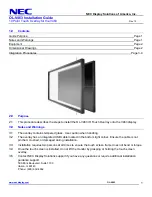
Yingli Solar G/G Modules, Installation and User Manual
page 3
Artificially concentrated light must not be directed on the front and rear surfaces
of PV modules.
Design Recommendations
Yingli Solar recommends that PV modules shall be mounted at a minimum tilt
angle of 10 degrees to allow for proper self-cleaning from normal rain showers.
PV modules are recommended to be installed at an optimized tilt angle to
maximize the energy output. It is roughly equal to the latitude of the project
site as a rule of thumb, facing the equator. But always to design based on local
situations to find out the optimum one.
Partial or complete shading of a PV module or modules can significantly reduce
system performance. Yingli Solar recommends minimizing the amount of shade
throughout the year to increase the amount of energy produced by the PV
modules.
Lightning protection is recommended for PV systems that are to be installed in
locations with high probability of lightning strikes.
High system voltages could be induced in the event of an indirect lightning
strike, which could cause damage to PV system components. The open area
of wire loops should be minimized (see Figure 5), in order to reduce the risk of
lightning induced voltage surges.
Figure 5: Wire loop design recommendation
Climate Conditions
PV modules may be installed in the following conditions for more than 30 years.
In addition to the required IEC certification, PV modules have also been tested to
verify resistance to ammonia fumes that may be present around barns sheltering
cattle, as well as suitability for installation in humid (coastal) areas and areas of
high sand storms.
Table 1: Environment of installation
E L E C T R I C A L I N S TA L L AT I O N
Electrical Configuration
Under normal conditions, a PV module is likely to experience conditions that
produce more current and/or voltage than reported at Standard Test Conditions
(Irradiance: 1000 W/m
2
, 25°C cell temperature and AM 1.5). The short-circuit
current (I
SC
) should be multiplied by a factor of 1.25 based on the highest
ambient temperature recorded, and the open-circuit voltage (V
OC
) should be
multiplied by a factor of up to 1.25 based on the lowest ambient temperature
recorded for the installation location when determining component voltage
ratings, conductor current ratings, fuse sizes, and size of controls connected to
the PV output.
This maximum voltage should not be exceeded at any time and, as the voltage of
the module increases, above datasheet values, at operating temperatures below
25°C, then these need to be taken into account when designing a PV system.
Voltages are additive when PV modules are connected directly in series, and
module currents are additive when PV modules are connected directly in parallel
(see Figure 6). PV modules with different electrical characteristics must not be
connected directly in series. The use of unsuitable third-party electronic devices
connected to PV modules may lead to mismatching, and must be installed
according to the manufacturer’s specified instructions.
Figure 6: Electrical diagrams of series and parallel wiring
The maximum voltage of the system must be less than the maximum certified
voltage, 1500V typically, and the maximum input voltage of the inverter and
of the other electrical devices installed in the system. To ensure that this is the
case, the open circuit voltage of the array string needs to be calculated at the
lowest expected ambient temperature for the location. This can be done by
using the following formula.
Max System voltage
≥
N * Voc * [1 +
β
Voc
* (Tmin-25)]
When the modules connect in parallel, the output current will be equal to the
sum of each branch current. It is suggested that every series module string
should be fused prior to be connected with other strings. Please refer to the
applicable regional and local codes for additional fuse requirements.
An appropriately rated overcurrent protection device must be used when the
reverse current could exceed the value of the maximum fuse rating of the
module. An overcurrent protection device is required for each series string if
more than two series strings are connected in parallel.
Cables and Wiring
Yingli Solar PV modules are provided with two (2) stranded, sunlight resistant
output cables that are terminated with PV connectors ready for most installations.
The positive (+) terminal has a female connector while the negative (-) terminal
has a male connector. The module wiring is intended for series connections [i.e.
female (+) to male (-) interconnections, as shown in Figure 7], but can also be
used to connect suitable third-party electrical devices that may have alternative
wiring configurations so long as the manufacturer’s instructions are followed.
Use field wiring with suitable cross-sectional areas that are approved for use at
the maximum short-circuit current of the PV module. Yingli Solar recommends
to use only sunlight resistant waterproof cables qualified for direct current (DC)
wiring in PV systems. The minimum wire size should be 4 mm
2
.
Series Wiring (Voltage Additive)
Parallel Wiring (Current Additive)
Operating temperature
-40°C to +85°C
Storage temperature
-20°C to +50°C
Humidity
< 85%RH
Altitude
≤
2000m
Notes:
The modules have been evaluated by TUV according to IEC61215 for a maximum positive design loading
of 3600 Pa, and negative design loading 1600 Pa, with 1.5 times safety factor.
The mechanical load bearing is dependent upon the mounting methods used and failure to follow the
instructions in this manual may result in different capabilities to withstand snow and wind loads.
The system installer must ensure that the installation methods used meet these requirements and any
local codes and regulations.
Where
N
Number of modules in series
Voc
Open circuit voltage of each module (refer to product label or datasheet)
β
Voc
Thermal coefficient of open circuit voltage for the module (refer to datasheet)
Tmin
The lowest ambient temperature





























